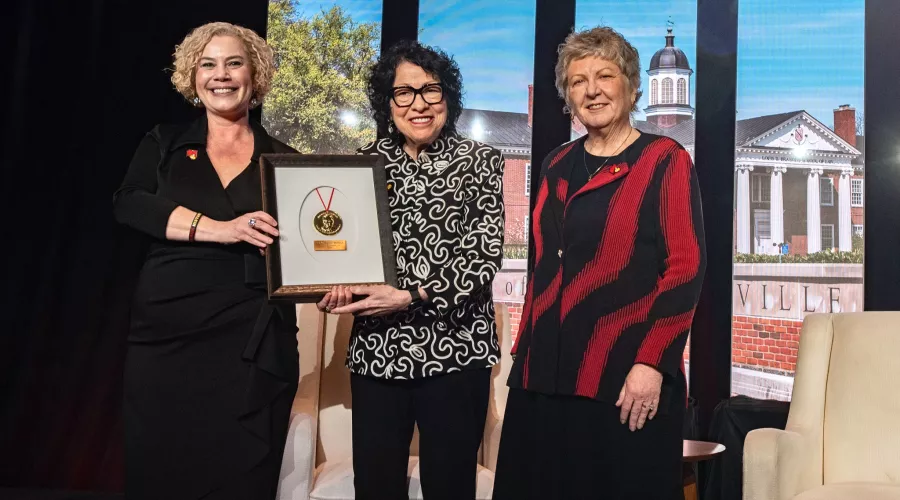U.S. Supreme Court Justice Sonia Sotomayor awarded highest honor from UofL Brandeis School of Law
February 14, 2025
“If you start from the proposition that most people have good in them, it’s easier to find common ground.” – U.S. Supreme Court Justice Sonia Sotomayor
The University of Louisville Louis D. Brandeis School of Law presented the Brandeis Medal to U.S. Supreme Court Justice Sonia Sotomayor on Feb. 5, during a reception at Louisville’s Marriott Hotel Downtown.
The Brandeis Medal, awarded annually since 1983, honors a recipient chosen for their devotion to economic, social or political justice and for advancing the cause of public service in the legal profession. Sotomayor, an alum of Princeton University and Yale Law School, is the seventh Supreme Court justice honored with the medal, following Harry Blackmun, Stephen Breyer, Ruth Bader Ginsburg, Elena Kagan, Sandra Day O’Connor and John Paul Stevens.
“We selected Justice Sotomayor to receive the Brandeis Medal because she brings tremendous dignity, respect and compassion to the bench. She is a fierce defender of liberty,” said Dean of Louis D. Brandeis School of Law Melanie B. Jacobs. “Every student who is in this room who was at the law school today and got to interact with Justice Sotomayor is nodding and thinking of the way in which she touched them.
The “people’s justice”
Appointed by Barack Obama in August 2009, Sotomayor became the first Hispanic and third woman to serve on the high court. Aptly, Sotomayor was introduced at the Brandeis event by Enid Trucios-Haynes, the first Hispanic law professor at UofL, and like Sotomayor, a native New Yorker from the Bronx. Trucios-Haynes said Sotomayor has served as a personal mentor and role model for the marginalized, underserved and disadvantaged in her 15 years on the bench, writing impassioned rulings and dissents on issues of race, gender and ethnic identity.
Sometimes dubbed “the people’s justice,” Sotomayor is known for decisions such as legalizing same-sex marriage and upholding the Affordable Care Act, as well as her concern for the rights of criminal defendants and criminal justice reform.
In providing greetings from the Commonwealth of Kentucky, Gov. Andy Beshear said the Supreme Court holds “a sacred duty to rule without bias or favor to any person or party.” The justices of the Supreme Court are “the very foundation of a functional system of government, one that’s designed to serve the people and not just the powerful.”
UofL President Kim Schatzel welcomed Sotomayor who then participated in a question-and-answer session with Jacobs.
The justice spoke candidly about her upbringing in an impoverished, high-crime housing project in New York City. She also discussed the positive influence of her grandmother and how life experiences had informed her philosophies on law and life.
“I felt loved, I never felt poor,” she said. “It was a hard life, but it was a life filled with joy. Poor people are not bad people, they’re just poor, but many people don’t understand the difference. They think poverty is your own fault.”
The law is not black and white
Sotomayor described the delicate balance of interpreting the law, noting how she has encountered defendants who made bad choices, yet were willing to change their behavior. Other times, she met defendants unwilling to see their wrongs.
“Our judgment as a society must understand this difference,” she said. “That’s what my childhood taught me. The law is not black and white, it’s gray, and in that gray area is where judges and lawyers work.”
When asked how she has been successful in considering both sides of an issue, the justice responded, “We have to have balance in facing our problems, and the only way to have that balance is to be open to both sides of the conversation.
“Justice (Clarence) Thomas and I, for example, are well-known for frequently being on the opposite side of issues, but no one is more loyal to the people he works with and loves.
“The fundamental difference between us is that he believes every person is capable of lifting themselves up by the bootstraps, while I understand from my life experiences that some people need help getting their boots up so they can reach their bootstraps,” Sotomayor said. “If you start from the proposition that most people have good in them, it’s easier to find common ground.”
On another topic, Jacobs asked Sotomayor what is needed to restore eroded trust in the judiciary.
“The court would garner better support if it acted more slowly in undoing precedent,” said Sotomayor. “If we as a court go too far ahead of people, our legitimacy is going to be questioned, and I think the immunity case is one of those situations. I don’t think Americans have accepted that anyone should be above the law in America — even the president.”
Inspiring the next generation
While in Louisville, Sotomayor met with law students, a rare opportunity for the aspiring attorneys. She also visited students in the Central High School Law and Government Magnet Program, a UofL Signature Partnership program in which high schoolers are taught by Brandeis School of Law students to encourage minority participation in the legal profession.
Third-year law student Andi Dahmer explained how special it was to hear Sotomayor’s lived experiences come to life, and asked the justice this question: In a period of such uncertainty both domestically and abroad, what is one thing that brings you hope for the future with regard to the rule of law?
“In response, without missing a beat, she looked at us and said ‘you,’ meaning the youth, the students in the room,” Dahmer said. “I thought it was a very profound answer, and I was so honored that she said students of our generation give her such hope.”
Dahmer also said she was awestruck by the friendly presence of Justice Sotomayor.
Carcyle Barrett, also a third-year law student, felt a deep connection with Sotomayor’s journey in terms of challenges and aspirations. Both Barrett and Sotomayor hail from working class families in New York with migrant or immigrant parents.
“She had to navigate spaces where her potential was doubted by people, but in her persistence, she didn’t let anyone stop her,” said Barrett. “It resonates for me that her presence and diverse representation on the Supreme Court is needed to help shape the law.”
Further, Barrett said she was encouraged by the justice’s comments that success isn’t just about talent.
“She told us it’s about resilience, authenticity and staying true to your values,” Barrett said. “I think Justice Sotomayor’s ability to remain grounded and connected to her roots while holding on to her position is a reminder that you can succeed without compromising who you are.”
Watch the video:
Related News



